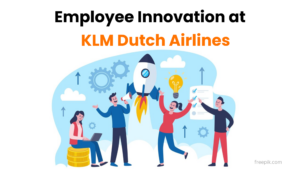We are reading and hearing so much lately about the things artificial intelligence could do and the industries it could revolutionize. How AI-driven innovation could automate operational tasks, leaving humans to focus more on innovative aspects of work, analyze huge data sets, identify trends, and enhance decision-making.
Essentially, this human and AI collaboration is making innovation accessible to all.
In fact, a study by Ernst & Young found that 84% of US CEOs and business leaders consider human-AI collaboration the key to a company’s success in the current landscape.
Yet still, artificial intelligence and innovation, together, remains an uncharted territory for most of the businesses across the globe.
Reasons?
- Artificial intelligence, the term itself, is intimidating to so many people. Even though AI-driven innovation simply refers to employing AI technology to streamline innovation management.
- Genuine concerns for security and privacy lead to resistance to adopting AI for innovation. Even though best AI-powered innovation tools adhere to Responsible AI and innovation best practices or standards.
If you are looking for a detailed answer to what is artificial intelligence, this is not the right article for you. You might want to visit Wikipedia: Artificial Intelligence for a deeper understanding.
However, if you want to know what is the role of AI in innovation and explore examples of AI, you are in for a knowledge treat.
Let’s look at innovation from an ecosystem perspective and how AI helps in achieving this initiative within the organization.
How is AI driving innovation in organizations?
So, what is the role of artificial intelligence in business innovation?
‘Cause it doesn’t matter in which specific industry your business operates, AI driven innovation is enabling new capabilities, improving efficiencies, and transforming traditional processes.
Here’s a drill down!
#1 Democratization of Innovation
AI in the workplace is democratizing innovation by making advanced technologies and capabilities accessible to a broader range of employees, fostering a culture of innovation, and streamlining processes across various departments.
Traditionally, innovation initiatives were often confined to specialized teams or departments, such as R&D or product development, and were driven by a select group of experts.
However, with AI as an innovation tool, organizations are increasingly breaking down these orthodox barriers and democratizing innovation in several ways.
An employee belonging to a technical background can contribute to creative processes and vice versa.
For example, a UI/UX designer with no extensive coding knowledge can now build impressive website architectures with the help of low-code AI platforms. These platforms even provide pre-built AI modules for tasks like predictive maintenance and quality control.
Similarly, a small business owner with no commercial security experience can better-secure their business using AI security cameras. These devices leverage ML algorithms and enable spotting & warning operators of anomalous events that could pose a security threat.
Another use case is the direct implementation of AI innovation software that takes care of end-to-end idea and innovation management.
#2 Idea Generation and Discovery
AI idea generators embedded in AI-powered innovation systems are the best catalysts for innovative ideas.
Anyone can come up with innovative ideas. However, individuals seldom know where to begin or whom to approach. If they do, their ideas lack a strong conviction for implementation.
However, the combination of AI and ideation leads to AI-balanced innovation.
Imagine you had unlimited resources for a project. What bold, audacious innovation ideas would you pursue?
You might envision moonshot ideas–from creating a holographic interface to launching an AI-driven companion app. These seemingly extravagant ideas can actually spark new conversations and, surprisingly, lead to practical and innovative solutions.
With AI assistance, you or your team through analogical thinking, reverse thinking, and even prompting you to consider the constraints, can do wonders.
AI-driven semantic search capabilities even enhance idea discovery by enabling you to access and explore relevant information quickly and efficiently. Here’s how semantic search contributes to idea discovery:
- Contextual Understanding: Semantic search algorithms understand the context and meaning of your queries, delivering more accurate and relevant search results.
- Content Aggregation: AI-based features aggregate information from diverse sources, including internal databases, external repositories, and online resources. This comprehensive content repository provides a rich source of inspiration and reference material for any ideation process.
- Predictive Modeling: AI utilizes predictive modeling techniques to forecast future trends and anticipate emerging opportunities or challenges. By analyzing historical data and external factors, AI can identify market gaps and suggest innovative solutions to address them proactively.
Read Next: AI in IP: How Artificial Intelligence is Reshaping Innovation and Protection?
#3 Process Optimization and Workflow Automation
There’s so much excitement and interest in enterprises to make innovation accessible to every single individual, especially, using ai to drive business innovation and sustainability.
The question is how do we manage the pipeline and maintain the excitement?
How do we harness ideas from everyone everywhere and help them tell stories faster and more effectively?
This is where artificial intelligence and innovation management fit in.
The key role of AI, i.e., automation and instant productivity, leads to process optimization and automation in the context of idea management.
Here’s how it works:
Idea Submission
AI algorithms in ideation tools, like Idea Assist, help in capturing, categorizing, and prioritizing ideas submitted by employees across the organization.
By automatically capturing and organizing ideas from multiple devices and collaboration platforms, the tool ensures that no valuable insights are overlooked.
Evaluation and Review
Built-in AI features help analyze the potential impact, feasibility, and alignment of ideas with strategic objectives.
AI-driven assessment innovation help in scoring and pursuing ideas based on predefined criteria, such as market potential, technical feasibility, and resource requirements. It helps organizations identify the most promising concepts for further consideration.
Workflow Routing
AI-driven workflow automation routes ideas to the appropriate stakeholders for review, feedback, and decision-making.
By dynamically assigning tasks and deadlines based on predefined rules and roles, AI innovation systems ensure that ideas move through the evaluation process efficiently and transparently.
Notifications and Reminders
AI algorithms generate automated notifications and reminders to keep stakeholders informed about the status of their ideas and upcoming deadlines.
By proactively engaging participants and keeping them updated on progress, these AI tools foster engagement and accountability throughout the innovation lifecycle.
#4 Collaboration and Engagement
Collaboration is crucial for innovation, and AI facilitates effective collaboration within organizations across multiple bases around the world.
Picture this: A team of innovators spread out across the globe, each with their own unique ideas and expertise.
In the past, collaborating on innovative projects would’ve been a logistical nightmare. But with AI in the mix, it’s a whole new ball game!
Whether you’re in Tokyo, Paris, or New York, everyone’s on the same page, sharing ideas and insights effortlessly.
And when it comes to bringing those ideas to life, AI streamlines the process like never before. Automated communication tools keep everyone in sync, sending reminders, updates, and notifications so no brilliant idea gets lost in the shuffle.
But it’s not just about keeping track of progress.
AI helps spark creativity, too!
With huge data sets available, teams can uncover hidden patterns and insights, inspiring new ideas and directions for innovation.
And let’s not forget about collaboration platforms powered by AI. Teams don’t even have to move out of their favorite tools, such as Teams or Google Chat, to collaborate on ideas and document them simultaneously.
#5 IP Portfolio Development
Latest research and studies show that organizations encounter the following portfolio management challenges:
- increased workload,
- reduced headcount,
- time constraints,
- manual tasks,
- risk management,
- global team collaboration,
- the need for reliable technology.
As companies look to increase their operations and introduce new products and services, they need their IP portfolios to grow.
This requires employees to engage proactively in innovation, submit more invention disclosures, and patent counsels to be ever-vigilant.
Despite all this, many IP management processes still rely heavily on manual tasks, leading to inefficiencies and errors.
But AI-powered innovation tools are making it all easy and efficient.
From capturing ideas, performing AI-powered prior art search, collaborating with IP counsels, drafting attorneys, co-innovators, and everything in between all at one place, portfolio management is now streamlined.
Impact of AI on Innovation Pipeline
What are some of the benefits of AI driven innovation? AI is accelerating innovation within organizations at an unprecedented rate. But that’s not it, let’s look at the impact at a granular level:
- Accelerated Idea Generation: According to a study by McKinsey, companies that leverage AI for data analysis see a 19% increase in innovation output.
- Enhanced Idea Evaluation: Research by PwC found that 54% of executives believe AI helps identify valuable opportunities for growth and innovation. IBM Watson’s AI-powered analytics tools assist in evaluating ideas by predicting their potential impact on revenue, market share, and customer satisfaction.
- Increased Innovation Portfolio: Our internal client performance analytics show that within an year of adopting an AI-powered innovation management system:
- the percentage of ideas captured and invention disclosures submitted increase by an average of 61%
- 50% higher collaboration rate with most number of ideas and disclosures submitted within teams
- Enhanced Collaboration and Knowledge Sharing: According to a study by Harvard Business Review, organizations that promote AI-driven collaboration experience a 30% increase in innovation output. This highlights the role of AI in facilitating cross-functional collaboration and knowledge exchange.
Read Next: AI-First Approach: Why Leading Companies Are Adopting It & How You Can Too
Check whether or not you are ready to adopt AI in your innovation endeavors.
10 Latest Innovations in Artificial Intelligence Leading Business Success
Here are the examples of artificial intelligence (AI) innovations by renowned companies that are already on their way to the market or are expected to arrive in the near future.
#1 InspireIP is exploring building AI-powered co-innovator matchmaking
Imagine a platform that connects you with the perfect innovation partner automatically. A co-innovator that:
- Shares your vision
- Compliments your skills
- Adds invaluable insights to your project
InspireIP is in the validation phase of building an AI-powered Matchmaker feature that processes vast amounts of data, uncovers patterns, and analyze prompts to find the best innovator for a particular project.
Find out more:
#2 OpenAI just recently revealed its ChatGPT AI Voice Assistant
OpenAI recently introduced the ChatGPT AI Voice Assistant, enabling users to engage with ChatGPT through voice interactions. This advancement enhances user experiences and productivity by providing more natural and seamless interactions with AI-driven systems and services.
#3 Meta is exploring building AI-powered earphones with cameras
Meta’s exploration of AI-powered earphones with cameras signals a significant advancement in wearable tech. These devices combine cameras and AI to offer discreet photo and video capture, potentially revolutionizing how we interact with our surroundings. They could enable augmented reality experiences and provide contextual information, though privacy considerations are crucial.
#4 NASA appoints its first chief A.I. officer / chief innovation officer
This is a significant milestone in the organization’s embrace of artificial intelligence role in space exploration and scientific discovery.
As Chief AI Officer or Chief Innovation Officer, the appointed individual will play a pivotal role in shaping NASA’s AI strategy, spearheading initiatives to harness AI technologies for data analysis, mission planning, robotic exploration, and more.
They will also lead efforts to promote a culture of innovation within NASA, encouraging collaboration, experimentation, and the exploration of new ideas and approaches across the organization.
#5 Bumble founder says AI will change the rules of dating
The future of online dating will involve AI bots talking to each other. The founder of Bumble predicts that AI will transform dating by revolutionizing matchmaking algorithms, enhancing safety measures, personalizing user experiences, and continuously optimizing dating platforms based on user feedback.
#6 Perplexity AI partners with SoundHound AI
Perplexity AI’s partnership with SoundHound AI represents a significant collaboration aimed at integrating Large Language Models (LLMs) into voice assistants for use in cars and Internet of Things (IoT) devices. This partnership will enhance voice assistant capabilities, enabling more natural and intelligent interactions for users across various platforms and environments.
#7 SoftBank’s Arm will launch AI chips
SoftBank’s Arm announcing the launch of AI chips by 2025 reflects the company’s strategic move to tap into the rapidly growing demand for artificial intelligence technologies. These AI chips are poised to cater to a burgeoning market hungry for advanced computing solutions tailored specifically for AI workloads. This initiative underscores Arm’s commitment to innovation and its vision to play a pivotal role in shaping the future of AI-driven technologies.
#8 Google partners with Airtel
Google’s partnership with Airtel to provide cloud services and GenAI products to Indian businesses signifies a significant collaboration aimed at driving digital transformation and innovation within the Indian market.
This partnership leverages Google’s expertise in cloud computing and artificial intelligence to empower Indian businesses with scalable and cutting-edge solutions. By combining Google’s technology prowess with Airtel’s extensive network infrastructure and market reach, this partnership aims to unlock new opportunities and drive growth for businesses across various industries in India.
#9 Intelligent personal assistance
Both Google Assistant and Apple Siri exemplify the growing importance of artificial intelligence in enabling more intuitive and efficient human-computer interactions. As these technologies continue to evolve, they are expected to play an increasingly integral role in shaping how we interact with technology and access information in our daily lives.
#10 Adobe introduces Acrobat AI Assistant for enterprises
Adobe’s introduction of the Acrobat AI Assistant for enterprises marks a significant advancement in document management and productivity.
This AI-powered assistant leverages machine learning algorithms to streamline document workflows, automate repetitive tasks, and enhance collaboration within organizations.
By integrating with Adobe Acrobat, the AI Assistant offers features such as intelligent document tagging, content extraction, and automated analysis, enabling enterprises to improve efficiency, accuracy, and compliance in managing their documents.
These AI innovation examples are proof that every industry is making use of artificial intelligence to increase their innovation efforts.
What’s more?
Beside the roles and impacts mentioned above, here’s where AI improves innovation.
- Risk assessment and management
- Data-driven decision making
- Inclusivity and participation
- Transparency and communication
- Continuous learning and improvement
- Accelerated innovation processes
- Increased employee engagement and satisfaction
- Cost reduction
- Lowered technical barriers
- AI-Powered security systems and disaster response coordination



